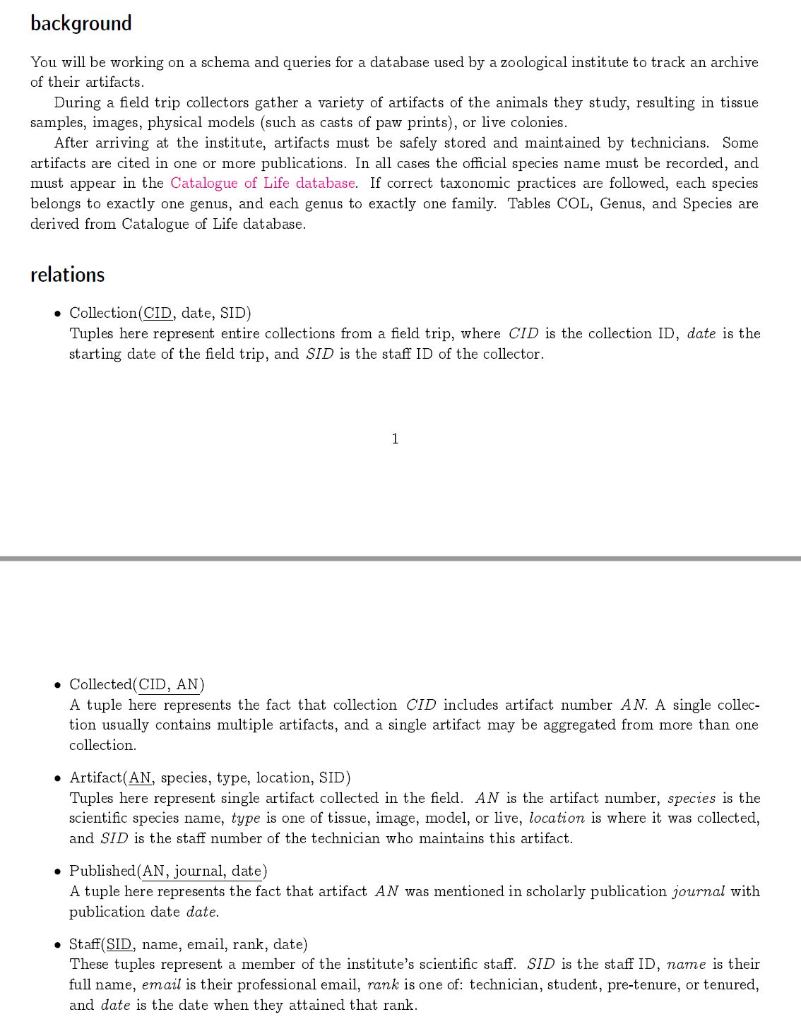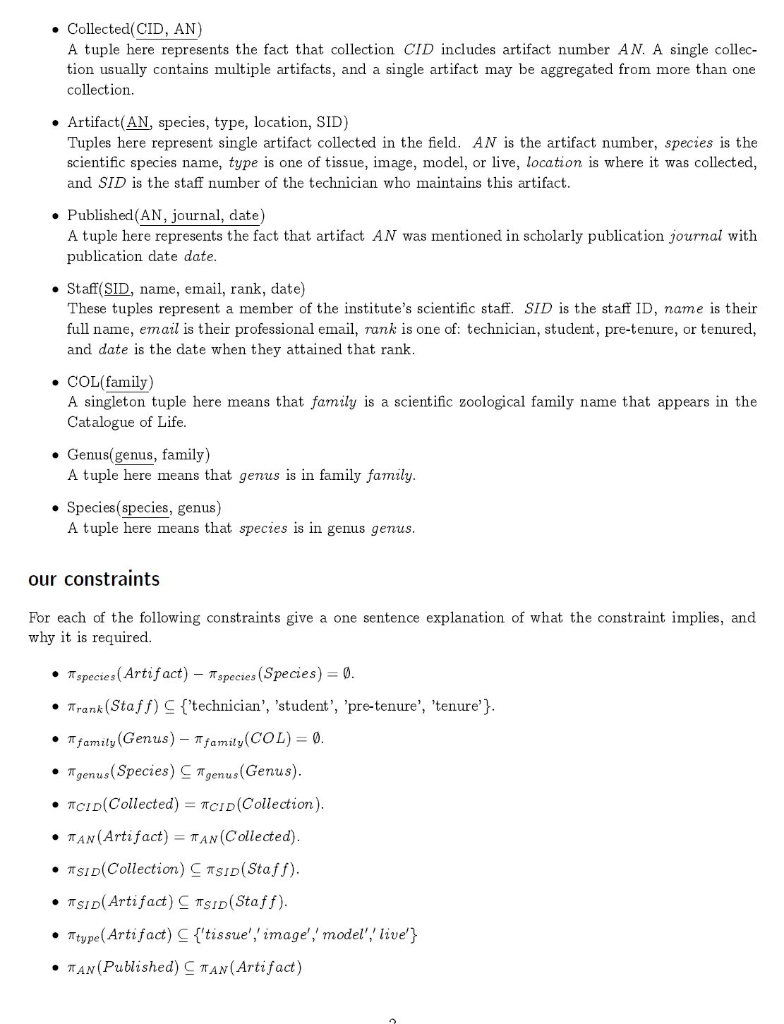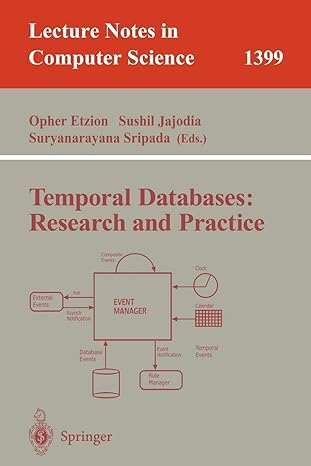Answered step by step
Verified Expert Solution
Question
1 Approved Answer
can someone please help me with question 6 and 8? thanks. No data is available. That's all that is given. background You will be working



can someone please help me with question 6 and 8? thanks.
No data is available. That's all that is given.
background You will be working on a schema and queries for a database used by a zoological institute to track an archive of their artifacts. During a field trip collectors gather a variety of artifacts of the animals they study, resulting in tissue samples, images, physical models (such as casts of paw prints), or live colonies. After arriving at the institute, artifacts must be safely stored and maintained by technicians. Some artifacts are cited in one or more publications. In all cases the official species name must be recorded, and must appear in the Catalogue of Life database. If correct taxonomic practices are followed, each species belongs to exactly one genus, and each genus to exactly one family. Tables COL, Genus, and Species are derived from Catalogue of Life database. relations Collection(CID, date, SID) Tuples here represent entire collections from a field trip, where CID is the collection ID, date is the starting date of the field trip, and SID is the staff ID of the collector Collected(CID, AN) A tuple here represents the fact that collection CID includes artifact number AN. A single collec- tion usually contains multiple artifacts, and a single artifact may be aggregated from more than one collection Artifact(AN, species, type, location, SID) Tuples here represent single artifact collected in the field. AN is the artifact number, species is the scientific species name, type is one of tissue, image, model, or live, location is where it was collected, and SID is the staff number of the technician who maintains this artifact. Published(AN, journal, date) A tuple here represents the fact that artifact AN was mentioned in scholarly publication journal with publication date date. Staff(SID, name, email, rank, date) These tuples represent a member of the institute's scientific staff. SID is the staff ID, name is their full name, email is their professional email, rank is one of: technician, student, pre-tenure, or tenured, and date is the date when they attained that rank. Collected(CID, AN) A tuple here represents the fact that collection CID includes artifact number AN. A single collec- tion usually contains multiple artifacts, and a single artifact may be aggregated from more than one collection. Artifact(AN, species, type, location, SID) Tuples here represent single artifact collected in the field. AN is the artifact number, species is the scientific species name, type is one of tissue, image, model, or live, location is where it was collected, and SID is the staff number of the technician who maintains this artifact. Published(AN, journal, date) A tuple here represents the fact that artifact AN was mentioned in scholarly publication journal with publication date date. Staff(SID, name, email, rank, date) These tuples represent a member of the institute's scientific staff. SID is the staff ID, name is their full name, email is their professional email, rank is one of: technician, student, pre-tenure, or tenured, and date is the date when they attained that rank. COL(family) A singleton tuple here means that family is a scientific zoological family name that appears in the Catalogue of Life. Genus(genus, family) A tuple here means that genus is in family family. Species species, genus) A tuple here means that species is in genus genus. our constraints For each of the following constraints give a one sentence explanation of what the constraint implies, and why it is required. species (Artifact) species (Species) = 0. Frank (Staff) {technician', 'student', 'pre-tenure', 'tenure'}. Ifamily(Genus) Tfamily(COL) = 0. Agenus (Species) CFgenus (Genus). TCID(Collected) = *CID (Collection). TAN(Artifact) = tan(Collected). SID(Collection) TTSID(Staff). TSID(Artifact) C TSID(Staff). Atype (Artifact) ${'tissue', image', model','live'} TAN(Published) STAN(Artifact) queries Write relational algebra expressions for each of the queries below. You must use notations from this course and operators: 77,0, , 4, condition, X, n, U, -, = You may also use constants: today (for current date) 0 (for the empty set) In your queries pay attention to the following: All relations are sets, and you may only use relational algebra operators covered in Chapter 2 of the course text. Do not make assumptions that are not enforced by our constraints above, so your queries should work correctly for any database that obeys our schema and constraints. Other than constants such as 23 or "lupus", a select operation only examines values contained in a tuple, not aggregated over an entire column. Your selection conditions can use arithmetic operators, such as +,5,#,,>,,Step by Step Solution
There are 3 Steps involved in it
Step: 1

Get Instant Access to Expert-Tailored Solutions
See step-by-step solutions with expert insights and AI powered tools for academic success
Step: 2

Step: 3

Ace Your Homework with AI
Get the answers you need in no time with our AI-driven, step-by-step assistance
Get Started


